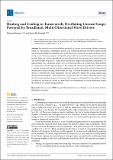Files in this item
Heating and cooling in transversely oscillating coronal loops powered by broadband, multi-directional wave drivers
Item metadata
| dc.contributor.author | Howson, Thomas | |
| dc.contributor.author | De Moortel, Ineke | |
| dc.date.accessioned | 2023-01-30T11:30:10Z | |
| dc.date.available | 2023-01-30T11:30:10Z | |
| dc.date.issued | 2023-01-29 | |
| dc.identifier | 282875555 | |
| dc.identifier | ab128078-6e71-48b5-8e41-3ebb444fa476 | |
| dc.identifier | 85151081764 | |
| dc.identifier.citation | Howson , T & De Moortel , I 2023 , ' Heating and cooling in transversely oscillating coronal loops powered by broadband, multi-directional wave drivers ' , Physics , vol. 5 , no. 1 , pp. 140-160 . https://doi.org/10.3390/physics5010011 | en |
| dc.identifier.issn | 2624-8174 | |
| dc.identifier.other | ORCID: /0000-0002-4895-6277/work/128097231 | |
| dc.identifier.other | ORCID: /0000-0002-1452-9330/work/128097769 | |
| dc.identifier.uri | https://hdl.handle.net/10023/26850 | |
| dc.description | Funding: The research leading to these results has received funding from the UK Science and Technology Facilities Council (consolidated grants ST/S000402/1 and ST/W001195/1). IDM received funding from the Research Council of Norway through its Centres of Excellence scheme, project number 262622. | en |
| dc.description.abstract | Recent studies have identified the potential for coronal wave heating to balance radiative losses in a transversely oscillating low-density loop undergoing resonant absorption, phase mixing and the Kelvin-Helmholtz instability. This result relied on a continuous, resonant oscillatory driver acting on one of the loop footpoints and similar setups with non-resonant driving produce insufficient heating. Here, we consider broadband and multi-directional drivers with power in both resonant and non-resonant frequencies. Using three dimensional magnetohydrodynamics simulations, we impose transverse, continuous velocity drivers at the footpoints of a coronal loop which is dense in comparison to the background plasma. We include the effects of optically thin radiation and a uniform background heating term which maintains the temperature of the external plasma but is insufficient to balance energy losses within the loop. For both broadband and multi-directional drivers, we find that the energy dissipation rates are sufficient to balance the average energy losses throughout the simulation volume. Resonant components of the wave driver efficiently inject energy into the system and these frequencies dominate the energetics. Although the mean radiative losses are balanced, the loop core cools in all cases as the wave heating rates are locally insufficient, despite the relatively low density considered here. | |
| dc.format.extent | 21 | |
| dc.format.extent | 6507429 | |
| dc.language.iso | eng | |
| dc.relation.ispartof | Physics | en |
| dc.subject | Solar corona | en |
| dc.subject | MHD (magnetohydrodynamics) oscillations | en |
| dc.subject | Wave heating | en |
| dc.subject | Kelvin-Helmholtz instability | en |
| dc.subject | QB Astronomy | en |
| dc.subject | QC Physics | en |
| dc.subject | T-DAS | en |
| dc.subject | MCC | en |
| dc.subject.lcc | QB | en |
| dc.subject.lcc | QC | en |
| dc.title | Heating and cooling in transversely oscillating coronal loops powered by broadband, multi-directional wave drivers | en |
| dc.type | Journal article | en |
| dc.contributor.sponsor | Science & Technology Facilities Council | en |
| dc.contributor.institution | University of St Andrews. Applied Mathematics | en |
| dc.contributor.institution | University of St Andrews. Office of the Principal | en |
| dc.identifier.doi | https://doi.org/10.3390/physics5010011 | |
| dc.description.status | Peer reviewed | en |
| dc.identifier.url | https://www.mdpi.com/2624-8174/5/1/11 | en |
| dc.identifier.grantnumber | ST/W001195/1 | en |
This item appears in the following Collection(s)
Items in the St Andrews Research Repository are protected by copyright, with all rights reserved, unless otherwise indicated.

